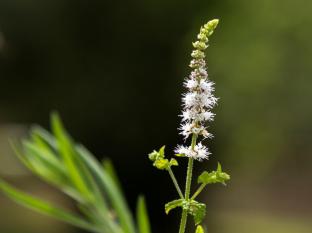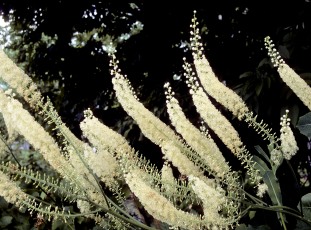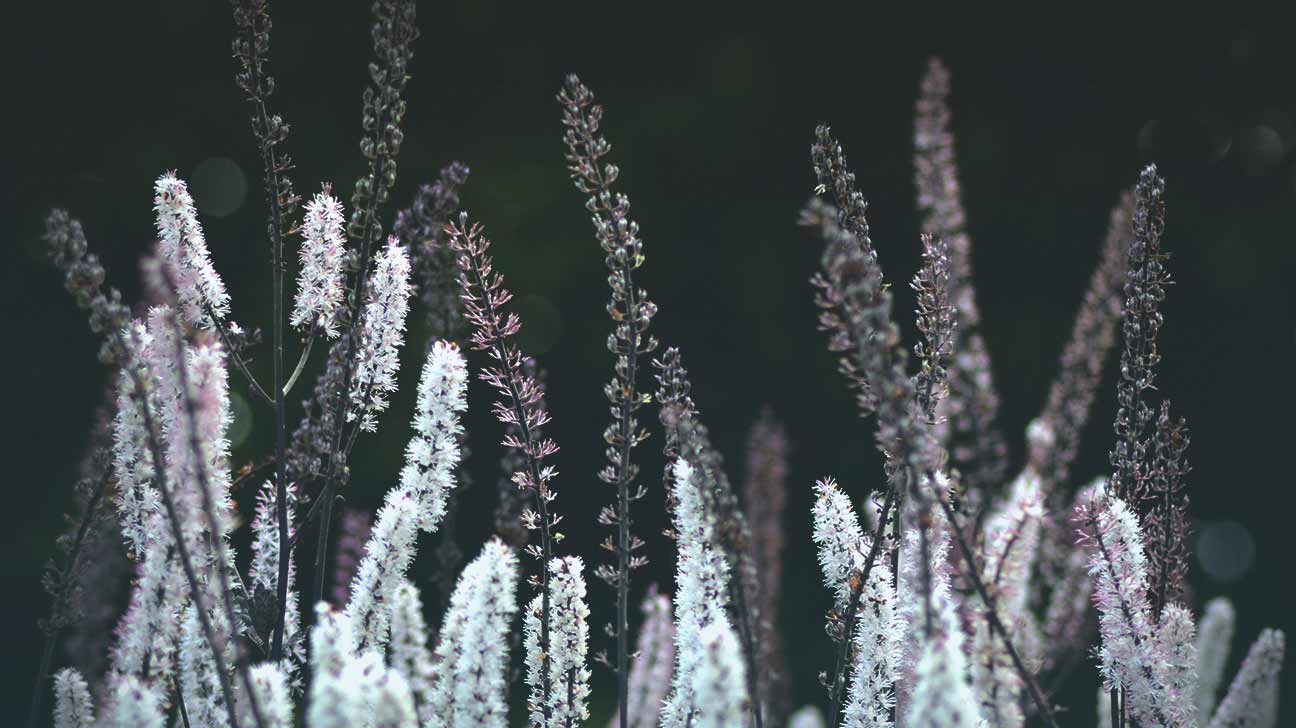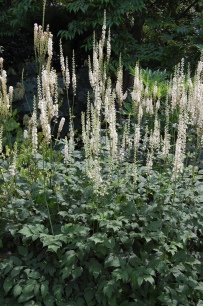
General Information:
Cimicifuga racemosa is a perennial rhizomatous flowering herb native to the eastern United States and part of Canada. Racemosa grows on the edges of deciduous woodlands, sprouting long floral spires that flower for about three weeks beetween june and august, reaching 4 to 6 feet in height. It goes by several common names: black cohosh, black bugbane, black snakeroot, and fairy candle. it gets the “black” in its name from the black seeds that rattle like the tail of a snake when shaken. This similarity caused Native Americans to use the root of the black cohosh as a treatment for snakebite, hence the name black snakeroot. It also has a particular, mildly unpleasant smell that led it to being called black bugbane.

Flowers and leaves of Cimicifuga racemosa

Traditional Uses:
The black cohosh has been a part of Native American medicinal practices for an unknown length of time. Its rhizomes – a type of underground stem – are the medicinally active part of the plant. The proper method of harvesting is to wait until the leaves start to die back during autumn and then harvest the thick, knobby rhizome.The list of archaic uses includes snakebite treatment, musculoskeletal pain, sore throat, fever, pneumonia, gynecological disorders, and even depression.

racemosa rhizome
Modern Uses:
Today, it is used as a treatment for the long list of symptoms related to menopause and menstruation. A review of scientific studies that have been conducted found a 26% reduction in night sweats and hot flashes while using commercially available black cohosh root supplements (Shams et al 2010).

The black seed heads contrast the white flowers quite nicely
Chemical Constituents
The primary active ingredients in black cohosh are phytoestrogenic lignans, some of which can only be found in the black cohosh. The plant also contains polyphenols, isoferulic acids, and glycosides, as well as coumarin, caffeic acid, and fukinolic acid.
Current Research:
Current research on the medical uses of black cohosh has found inconsistent results, so most sources say that its benefits are inconclusive. One study found that black cohosh binds to the opiate receptors in the ovary cells of hamsters. Most studies simply identify the chemicals found in the plant. Some studies report benefits and some report side effects such as an upset stomach or skin rashes. For possibility of liver damage, it is recommended that usage does not exceed twelve months.

Sources:
Beer, A., Osmers, R., Schnitker, J., Bai, W., Mueck, A. O., & Meden, H. (2013). Efficacy of black cohosh (Cimicifuga racemosa) medicines for treatment of menopausal symptoms – comments on major statements of the Cochrane Collaboration report 2012 “black cohosh (Cimicifugaspp.) for menopausal symptoms (review)”. Gynecological Endocrinology,29(12), 1022-1025. doi:10.3109/09513590.2013.831836
Jamróz, M. K., Jamróz, M. H., Dobrowolski, J. C., Gliński, J. A., Davey, M. H., & Wawer, I. (2011). Novel and unusual triterpene from Black Cohosh. Determination of structure of 9,10-seco-9,19-cyclolanostane xyloside (cimipodocarpaside) by NMR, IR and Raman spectroscopy and DFT calculations. Spectrochimica Acta Part A: Molecular and Biomolecular Spectroscopy,78(1), 107-112. doi:10.1016/j.saa.2010.09.005
Rhyu, M., Lu, J., Webster, D. E., Fabricant, D. S., Farnsworth, N. R., & Wang, Z. J. (2006). Black Cohosh (Actaea racemosa,Cimicifuga racemosa) Behaves as a Mixed Competitive Ligand and Partial Agonist at the Human μ Opiate Receptor. Journal of Agricultural and Food Chemistry,54(26), 9852-9857. doi:10.1021/jf062808u
Black Cohosh. (2016, November 29). Retrieved March 25, 2018, from https://nccih.nih.gov/health/blackcohosh/ataglance.htm
Office of Dietary Supplements – Black Cohosh. (n.d.). Retrieved March 25, 2018, from https://ods.od.nih.gov/factsheets/BlackCohosh-HealthProfessional/
Black Cohosh. (2018, March 22). Retrieved March 25, 2018, from https://www.herbazest.com/herbs/black-cohosh
Black Cohosh Benefits & Information (Cimicifuga Racemosa). (n.d.). Retrieved March 25, 2018, from https://www.herbwisdom.com/herb-black-cohosh.html
